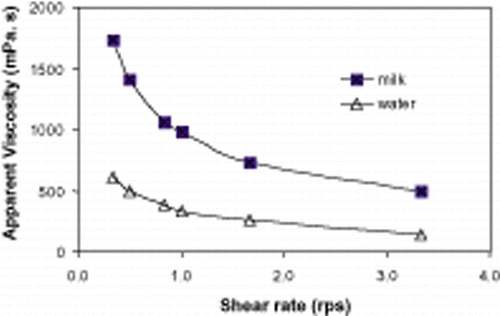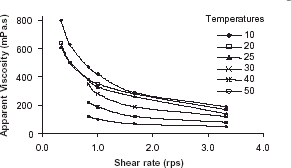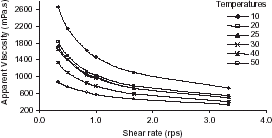Abstract
In this study, some physicochemical (solubility index, apparent density and dry matter content) and rheological properties of the hot salep, an indigenous Turkish beverage, were determined. The samples were prepared by adding water or milk to the commerical instant salep powder. The apparent viscosity of samples was measured in the temperature range of 10–50 °C, with the rotational speed of 20–200 rpm. The empirical power law model was used for the determination of the flow behavior and consistency indices of the samples. Dry matter content and apparent density of salp-milk beverage were significantly (p < 0.05) higher than those of salep-water counterpart. Apparent viscosity, consistency and flow behavior indices were also higher in the salep-milk samples. Salep-water sample was more pseudoplastic with lower flow behavior index. Since there is a close relationship between the rehological properties of beverages and consumer preference, the results might be useful in the formulation of instant hot salep beverages.
Keywords:
Introduction
Salep is a well known indigenous Turkish drink whose main ingredient is also called with the same name (salep powder). Hot salep, a viscous dairy beverage, is generally home-prepared and preferred particularly in winter. It is made by boiling salep powder and milk with sugar and served with cinnamon sprinkled on top. In recent years, high demand for hot salep beverage received the attention of manufacturers, and its instant form became available in the market.
Salep (powder) is white-colored flour obtained by milling of dried tubers of certain wild orchids (orchis species). It contains glucomannose, starch, moisture, and mineral matter.Citation1 The most important constituent of salep is glucomannose due to its stabilizing function.Citation2 Therefore, it has been mainly used as a stabilizer in some food formulations; however, it is also preferred for its characteristic flavor which plays an important role in the final product. In addition to its use in the preparation of hot salep beverage, powdered salep is also an essential ingredient for ice cream.
Instant salep which has recently been on the market is manufactured using various formulations. The basic ingredients of instant salep are sugar, milk powder, salep, stabilizer, and cinnamon. For the preparation of beverage from instant salep, hot water, or milk in the amount instructed on the package is added to the beverage powder and then stirred. The amount of sugar, milk powder, type, and concentration of hydrocolloids and flavor as well as processing conditions of the product affect the physical and sensory properties of the final product.Citation3 Citation4
Knowledge on the rheology of beverages is very valuable tool in the processing and quality control of the fluid foods. Its significance in product development in the food industry has been extensively discussed in literature.Citation5 Citation6 Citation7 Consumer preference is influenced from the flow behaviors of a beverage. For example, optimum consistency for a good mouthfeel is a desired quality criterion in the hot salep beverage. Liquid foods are classified as Newtonian and non-Newtonian fluids in terms of rheology according to the relationship between shear rate and shear stress of the solution.Citation8 Shear stress of Newtonian fluids is not depended on the shear rate while that of non-Newtonian fluids changes with varying shear rate. Various models such as Newton, Herschel-Bulkley and Power Law models are used to describe rheological properties of fluid food products.
Although the rheological properties of various dairy foods such as yogurt,Citation9 Citation10 concentrated yogurt (labneh),Citation11 Citation12 ayran,Citation13 ice cream mix,Citation14 Citation15 cheese,Citation16 and chocolate milkCitation3 have been studied, up to our knowledge there is currently no information available in the literature about rheological properties of instant salep beverage. In this study, the rheological and certain physicochemical properties (total solids, apparent density, and solubility index) of instant hot salep beverage were determined, and the applicability of empirical power-law model to describe the rheology of the product was investigated.
Materials and Methods
Samples
Instant salep powder with the moisture content of 5.11% (Dr. Oetker, Piyale, Co, Turkey) and milk (Yorsan Co, Turkey) were obtained from a local market. The main ingredients of instant salep were sugar, modified starch, nonfat dry milk, salep powder, and cinnamon as stated on the label of product. The label on the package specified that 100 mL of milk contained 3.1 g protein, 4.5 g carbohydrate, and 3.0 g fat. In this study, two forms of salep beverage were prepared using milk or water. The first one was prepared by addition of boiled milk to instant salep, and the boiled water was used instead of milk in the second form. For instance, 40 g instant salep and 300 mL liquid (milk or water) were vigorously stirred for about 5 min using a glass bar in a beaker until all solid particles were thoroughly dissolved. Physicochemical properties of samples were measured at ambient temperature. All analysis was carried out in triplicate.
Solubility Index
The solubility index (SI) was determined using a method described by American Dairy Products Institute.Citation17 Three drops of diglycol laurate were added to the sample to prevent foaming, and after leaving samples undisturbed for 15 min, it was stirred with a spoon for 5 s. It was then poured into a conical centrifuge tubes up to the 50 mL mark, and centrifuged (Nuve, Ankara) at 330 g (900 rpm, 360 mm radius) for 5 min, and the supernatant was discarded. The sediments were resuspended in distilled water, and centrifuged one more time for 5 min. The SI of the sample was determined from the volume (mL) of sediment left in each tube after the second centrifugation.
Apparent Density
Apparent density (AD) was determined according to the method described in literature.Citation18 A few drops of diglycol laurate were also added into the sample to prevent foam formation. The prepared sample was manually mixed in the cylinder for 3 min, held undisturbed for 1 h and mixed again for 1 min before the measurement of apparent density. The tared cylinder filled with sample was weight by GR200 balance (ANND, Japan) and the same cylinder was weight after filling it with distilled water. The ratio of sample to water gave the AD value.
Proximal Analysis
Dry matter (DM) content of samples were measured by weighing 10 g of sample in a petry dish and drying in an oven for 3 h at 102 ± 3°C.Citation19 Protein content was calculated from the percentage of nitrogen which was determined by UDK140 Kjeldahl analysis system (Velp, Italy). Ash contents of samples were determined by incineration of predried samples in oven at 500°C for 8 h. Fat content was measured using Gerber method.Citation19 A pH meter (Inolab, Germany) was used to determine the pH of samples.
Viscosity Measurement
The apparent viscosities (AV) of samples were determined using J.P. Selecta, s.a. Brand Viscometer (Viscostar-R, ST-TEMP, Spain,) at various temperatures (10, 20, 30, 40, and 50°C). Appropriate spindle (number 4) was used to obtain correct readings of AV in the shear rate range of 0.33–3.33 rps. Three readings from the same batch (150 mL) for each speed were taken 1 min interval and average value vs. speed was recorded as AV of the sample.
Statistical Analysis
All statistical calculations were completed using the SAS system.Citation20 One way Analysis of Variance (ANOVA) was carried out using the general linear model (GLM) procedure.
Results and Discussion
Physico-Chemical Properties
Some physico-chemical properties of the reconstituted salep samples were given in Table . Although the solubility index of milk-salep was higher than that of water-salep due to the certain amount of dry matter from milk, the difference was not statistically significant (p > 0.05). The apparent density (AD) also showed the similar trend and the value for salep–milk samples was significantly higher (p < 0.05) compared to that of salep–water. The average AD values were determined as 1.035 and 1.061 for reconstituted salep–water and salep–milk samples, respectively. Dry matter content of sample prepared with water was 12.30 g 100 g−1 sample and 23.58 g 100 g−1 sample for the sample prepared with milk. Protein content of salep–water sample was 9.08% in dry basis while that of salep milk was 18.49%. Fat content was 0.200% for salep–water and 2.20% for salep–milk. It was determined that total ash was 0.156 and 0.757% for reconstituted salep–water and salep–milk samples, respectively. Salep-water pH was 6.105 and salep–milk pH was 6.049.
Table 1 Physico-chemical properties of reconstituted salep beverages samples
Rheological Properties
The apparent viscosity of the hot salep beverage decreased with increasing shear rate for all samples as the sample showed pseudoplastic behavior. Shear-thinning behavior of sample was expected since weak physical bonds, electrostatic, and hydrophobic interactions affect the rheology of a milk product.Citation10 Citation21 Changes in apparent viscosity with respect to shear rate at 20°C was illustrated in Fig. . As shown in the figure, the apparent viscosity of salep–milk sample was higher than that of salep–water sample, because the reconstituted milk-salep evidently had higher solid content. Similar results were also observed at the other temperatures. These results agreed with published studies in the literature for various food samples such as pekmez (grape molasses)/tahin (sesame paste) blend, ice cream mix, and sunflower oil–water emulsions.Citation12 Citation22 Citation23 It was stated that the viscosity increase with higher solid content could be as a result of molecular movements and interfacial film formation.Citation24 Additionally, it should be noted that higher solid content in the solution causes the molecules come closer to each other; thus, some changes in structural network and ionic strength might occur and affect the intermolecular interactions.Citation4 As a result of these interactions, rheological behavior of sample changes; in relation, the apparent viscosity of sample increased. It could also be speculated that in the sample prepared with milk, caseins, and salep (hydrocolloid) may form a network of which could have consequences in the rheological behavior of the sample. It was reported that the viscosity of carrageenan added milk samples was dependent on carrageenan concentration and its tendency for the formation of a network with casein.Citation25 Similar results were also reported by other researchers.Citation3 Citation26
The apparent viscosity of samples in both forms of reconstituted salep–water and salep–milk increased with decreasing temperature as shown in Figs. and . A substantial viscosity increase was observed when the temperature decreased from 20 to 10°C and with increasing shear rate, the effect of temperature on the apparent viscosity became less prominent. This finding might be related to the behavior of stabilizer present in the instant salep in low temperature.
The power law model was used to describe the rheological properties of instant salep beverage. The flow behavior index (n) and consistency index (K) values were obtained by fitting the rotational speed vs. apparent viscosity values to the power law model.
Table 2 Effect of temperature on rheological parameters of reconstituted salep beverage
Conclusion
In this study it was determined that the rheological behavior of hot salep beverage prepared from commercial instant salep was depended on whether it was made by addition of milk or water. The temperature of the samples also affected the rheological properties. It was found that hot salep beverage prepared from commercial instant salep powder exhibited pseudoplastic behavior. Those samples prepared with milk had higher apparent viscosity, consistency, and flow behavior indices. It is known that rheological properties of liquid affect the consumer preferences; hence, the results obtained in this study could be used in the development of new instant salep beverage formulations. Also, the results in this study revealed that milk is recommended for the preparation of instant hot salep beverage in terms of the rheological properties of the product.
Acknowledgment
This work has been supported as financial by Erciyes University Scientific Research Project Unit (Project No: EUAP 01-51-7; Kayseri, Turkey).
References
- Tekinsen , O.C. and Karacabey , A. 1984 . Effect of Some Stabilizers Mix on Physical and Organoleptic Properties of Ice-Cream Kahramanmaras Type Ankara, , Turkey : Tubitak, Projects No: VHAG 594, Turkish Scientific and Technical Research Council . (Turkish)
- Tekinsen , O.C. 1996 . Dairy Technology 269 – 270 . Selcuk Universitesi Press . (Turkish)
- Yanes , M. , Duran , L. and Costell , E. 2002 . Rheological and optical properties of commercial chocolate milk beverages . J. Food Eng. , 51 : 229 – 234 .
- Alonsa-Mougan , M. , Meijide , F. , Jover , A. , Rodriguez-Nunez , E. and Vazquez-Tato , J. 2002 . Rheological behaviour of an amide pectin . J. Food Eng. , 55 : 123 – 129 . [CROSSREF]
- Steffe , J.F. 1992 . Rheological Methods in Food Process Engineering 158 – 162 . Michigan : Freeman Press .
- Rielly , C.D. 1997 . “ Food rheology ” . In Chemical Engineering for the Food Industry Edited by: Fryer , P.J. , Pyle , D.L. and Rielly , C.D. 195 – 233 . London : Blackie A.&P. .
- Sopade , P.A. and Kiaka , K. 2001 . Rheology and microstructure of sago starch from Papua New Guinea . J. Food Eng. , 50 : 47 – 57 . [CROSSREF]
- Genc , M. , Zorba , M. and Ova , G. 2002 . Determination of rheological properties of boza by using physical and sensory analysis . J. Food Eng. , 52 : 95 – 98 . [CROSSREF]
- Penna , A.L.B. , Sivieri , K. and Oliveira , M.N. 2001 . Relation between quality and rheological properties of lactic beverages . J. Food Eng. , 49 : 89 – 93 . [CROSSREF]
- Abu-Jdayil , A. and Mohameed , H. 2002 . Experimental and modelling studies of the flow properties of concentrated yogurt as affected by the storage time . J. Food Eng. , 52 : 359 – 365 . [CROSSREF]
- Abu-Jdayil , B. , Jumah , R.Y. and Shaker , R.R. 2002 . Rheological properties of a concentrated fermented product, labneh, produced from bovine milk: effect of production method . Int. J. Food Prop. , 5 ( 3 ) : 667 – 679 . [CROSSREF]
- Abu-Jdayil , B. , Shaker , R.R. and Jumah , R.Y. 2000 . Rheological behavior of concentrated yogurt (LABNEH) . Int. J. Food Prop. , 3 ( 2 ) : 207 – 216 .
- Koksoy , A. and Kilic , M. 2003 . Effect of water and salt level on rheological properties of ayran, a Turkish yoghurt drink . Int Dairy J. , 13 : 835 – 839 . [CROSSREF]
- Kaya , S. and Tekin , A.R. 2001 . The effect of salep content on the rheological characteristics of a typical ice-cream mix . J. Food Eng. , 47 : 59 – 62 . [CROSSREF]
- Keogh , M.K. , Murray , C.A. and Kennedy , B.T.O. 2003 . Effects of selected properties of ultrafiltered spray-dried milk powders on some properties of chocolate . Int. Dairy J. , 13 : 719 – 726 . [CROSSREF]
- Kahyaoglu , T. and Kaya , S. 2003 . Effects of heat treatment and fat reduction on the rheological and functional properties of Gaziantep cheese . Int. Dairy J. , 13 : 867 – 875 . [CROSSREF]
- ADPI. 1992 . Standarts for Grades of Dry Milks Including Methods of Analysis Chicago, IL, , USA : Bull. 916 ADPI .
- Mistry , V.V. and Pulgar , J.B. 1996 . Physical and storage properties of high milk protein powder . Int. Dairy J. , 6 : 195 – 203 . [CROSSREF]
- TSE (TS 1329). 1995 . Standard of Milk Powder Ankara, , Turkey : Turkish Institute of Standards . (Turkish)
- SAS. 1988 . SAS/STAT User's Guide(6.03) Cary, New York : SAS Institute, Inc. .
- Kinsella , J. 1984 . Milk proteins: physical chemical and functional properties . CRC. Crit. Rev. Food Sci. Nutr. , 21 : 197 – 262 .
- Alpaslan , M. and Hayta , M. 2002 . Rheological and sensory properties of pekmez (grape molasses)/tahin (sesame paste) blends . J. Food Eng. , 54 : 89 – 93 . [CROSSREF]
- Maskan , M. and Gogus , F. 2000 . Effect of sugar on the rheological properties of sunflower oil–water emulsions . J. Food Eng. , 43 : 173 – 177 . [CROSSREF]
- Bhattacharya , S. , Bhat , K.K. and Raghuver , K.G. 1992 . Rheology of bengal gram cicer arietinum flour suspensions . J. Food Eng. , 17 : 83 – 96 . [CROSSREF]
- Bixler , H.J. , Kevin , J. and Falshaw , R. 2001 . Kappa-2 carrageenan: structure and performance of commercial extracts II. Performance in two simulated dairy applications . Food Hydrocol. , 15 : 619 – 630 . [CROSSREF]
- Langendorff , V. , Cuvelier , G. , Michon , C. , Launay , B. , Parker , A. and De kruif , C.G. 2000 . Effect of carrageenan type on the behaviour of carrageenan/milk mixtures . Food Hydrocol. , 14 : 273 – 280 . [CROSSREF]
- Sopade , P.A. and Filibus , T.E. 1995 . The influence of solid and sugar contents on rheological characteristics of Akamu, a semi-liquid maize food . J. Food Eng. , 24 : 197 – 211 . [CROSSREF]


